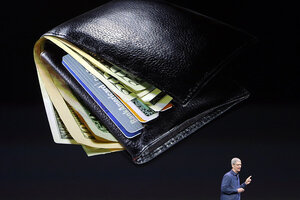Is Apple Pay more secure than traditional credit cards?
Apple Pay technology will remove from purchase transactions the traditional card features, like magnetic strips and security codes, that can make consumers vulnerable to fraud. Additionally, A consumer that loses a phone can use Apple’s Find My iPhone service to avoid having to cancel cards stored on the handset.

Apple CEO Tim Cook introduces Apple Pay on Tuesday, Sept. 9, 2014, in Cupertino, Calif.
Marcio Jose Sanchez/AP
Apple took the wraps off its iPhone 6 and the iPhone 6 Plus today, including a new mobile payment and digital wallet system called Apple Pay. Here’s how it may change the way owners of the smartphones handle their money.
Apple Pay will use near field communication (NFC) technology to make a wireless connection with a merchant’s cash register that’s in close proximity, letting customers pay with just a touch of their phone. This will remove from the transaction traditional card features that can make consumers vulnerable to fraud: exposed card numbers, security codes and the magnetic strips that hold the information. Apple Pay will generate a security code specific to each transaction for authentication purposes.
Owners can store their cards in Apple’s Passbook application by using the phone’s camera to take a picture of each one and verify account information with the issuing banks. The data are secured with TouchID, an Apple feature that lets phone owners use a fingerprint for authentication.
A consumer that loses a phone can use Apple’s Find My iPhone service to track down the device and avoid having to cancel cards stored on the handset. The company also introduced Apple Watch, which also can be used to buy things in stores with the mobile payments app.
Transactions made through Apple Pay reveal very little information to merchants. Cashiers don’t see your name, card number or security code, and Apple doesn’t get information about where you shopped, what you bought or how much you paid. To authorize a transaction, a consumer only needs to press the right finger to the phone screen using the TouchID system.
Apple Pay is supported by the three major U.S. credit card companies: MasterCard, Visa and American Express. These agreements may make it more likely to catch on than previously introduced mobile payment systems such as Google Wallet.
The biggest banks and card handlers – Bank of America, Wells Fargo, Citigroup, U.S. Bank, JPMorgan Chase, Capital One, United Services Automobile Association (USAA), Barclays, PNC Financial Services Group (PNC) and Navy Federal Credit Union – are all on board to handle transactions made with the Apple Pay. Between them, Apple says they handle 83% of credit card purchase volume.
Apple says 220,000 merchants accept mobile payment system transactions, including Macy’s, Bloomingdales, Walgreen’s, Staples, PetCo, Toys `R’ Us, Subway, Whole Foods, Disney, McDonald’s, Nike and more. Also signed up are Starbucks, Major League Baseball, Tickets.com, Instacart, Sephora and OpenTable.
Apple Pay will pair with e-commerce applications such as those used by Target, GroupOn, Uber and Panera. Users can make purchases through the apps and pay with one touch – no credit card number needed.
It’s too soon to tell how Apple Pay will be received by consumers and merchants. The new phones begin arriving Sept. 19, while consumers can start using Apple Pay at stores starting in October.

